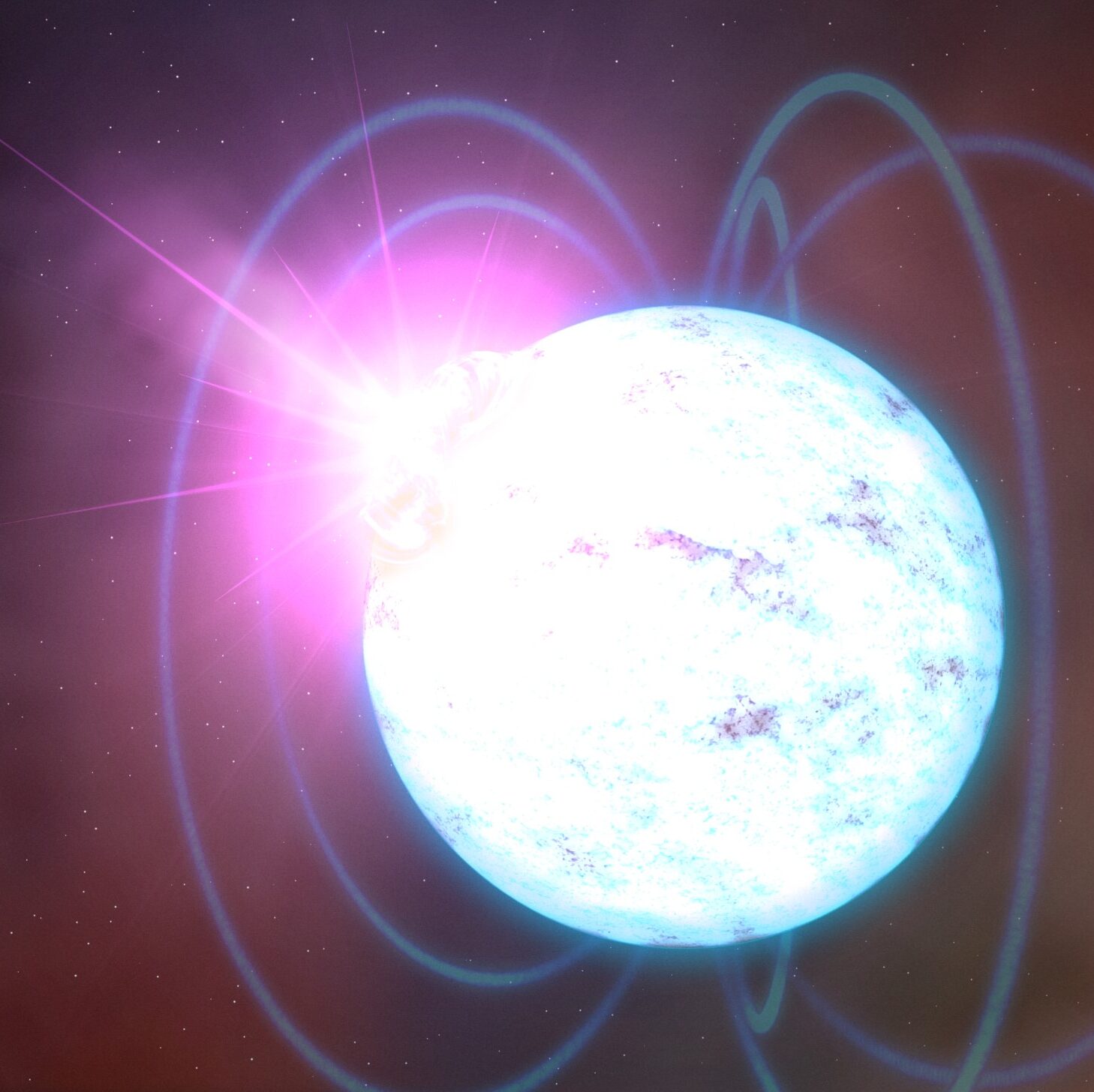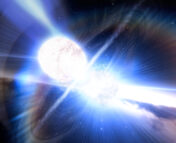Paper Title: Search for gravitational-wave transients associated with magnetar bursts in Advanced LIGO and Advanced Virgo data from the third observing run
Authors: The LIGO Scientific Collaboration, the Virgo Collaboration, and the KAGRA Collaboration
Status: ArXiv open access

Magnetars are extreme objects in our universe — highly magnetized neutron stars with magnetic fields on the order of 1015 Gauss. For reference, our Sun’s magnetic field is about 1 Gauss — this means that a magnetar magnetic field is an almost unimaginable thousand trillion times stronger than our Sun!
Magnetars emit in a number of different wavelengths, most notably in soft gamma-rays (which is the origin of many magnetars having the designation “SGR”, for soft gamma repeater), and in radio (they are the leading progenitor model for Fast Radio Bursts). They can also have extremely bright bursting periods, which look similar to (and are often categorized as) short Gamma Ray Bursts (GRBs). These bursts are called giant flares, which release a massive amount of energy in under a second! One such burst, GRB 200415A, which was from a magnetar in the galaxy NGC 253 released an energy equivalent to the amount emitted by our Sun over 100,000 years in only 0.016 seconds. The mechanisms for this emission are not yet clear, although there are some models which may give us insight.
But what about in messengers other than photons? In some models, the aforementioned giant flares and magnetar short bursts are the result of oscillations in the core or crust of the magnetar, which could mean that they produce gravitational waves in addition to photons. Today’s authors, members of the LIGO–Virgo–KAGRA (LVK) Collaborations, set out to see if we can detect gravitational wave counterparts to magnetar short bursts.
What would the gravitational wave emission we expect to see from magnetar bursts look like?
These authors focus on 2 known magnetars, with 12 bursts between them. The first is SGR 1935+2154, which has also been associated with an FRB, and Swift J1818.0-1607, which, in addition to being a magnetar, is also a radio pulsar. They also include 3 additional bursts, which have the same characteristics of the other magnetar bursts that aren’t well localized, but the authors attribute to another magnetar within the localization regions, 1 RXS J170849. This gives a total of 15 short bursts in the search, attributed to 3 sources. Each flare is chosen so that at least 2 detectors from LVK are in operating mode at the time of the burst.
These bursts are thought to excite two different types of oscillations – the fundamental (f-mode) and quasi-periodic oscillations (QPOs). The f-mode is thought to be excited when the magnetar’s internal magnetic field rearranges itself. QPOs, on the other hand, are other excited oscillation modes, which are longer-lived than the f-mode and can be seen in the tails of the flaring activity.
These authors search for both types with specialized searches. They search for f-mode oscillations in a short duration search, of 8 seconds centered on the burst. This short time scale allows them to optimize the sensitivity of the detectors by looking at the most probable time when the emission could occur. They also search the 500 seconds just after this window to check for any short-duration signals following the burst.
The long duration search covers the same time window, but extends out longer after the two short searches, up to 1400s (about 23 minutes) after the burst. This search targets the QPOs that occur in the tails of the burst.
Results and outlook to the future
Spoiler alert – these searches, though well motivated by the theory, don’t yet show any evidence of gravitational waves observed in the detectors. There are two bursts identified as the most significant in the short time window search, but both seem to be instrument artifacts. But, that doesn’t mean the story is over yet!
Using the distance to each magnetar, they are able to set constraints on the amount of energy emitted in gravitational waves during the burst. These upper limits can be seen in Figure 1. These upper limits show how much the current detectors can constrain the emission from magnetar short bursts; the amount of energy released from the bursts must be less than these upper limits.

These upper limits represent a significant improvement over previous searches – they are more than 10 times better than previous searches in the short duration search, and 1000 times better in the long duration search. Although there is no detection reported in this paper, these improvements give great insight into constraints on models for emission of both f-mode and QPO gravitational waves from magnetar bursts. These constraints are important to improving our understanding of the dynamics of the magnetic fields in magnetars.
There are now 30 known magnetars [1] and with the next LVK data run (observing run O4), planned to start in March of 2023, more data will be available both on the electromagnetic and gravitational wave sides of the equation. This search was limited in the number of bursts (only 15 bursts from 3 magnetars) due to the requirement that LVK has at least 2 detectors operating during the burst and a limited number of magnetar short bursts that have been identified. More data available, and more sensitive detectors, would allow for more sources and bursts to be analyzed, which would give a higher chance for a significant detection!
Edited: the sources considered in this search are magnetar short bursts, not giant flares.
Edited by: Sahil Hegde
Featured image credit: NASA’s Goddard Space Flight Center, Public domain, via Wikimedia Commons
[1] Olausen, S. A. and Kaspi, V. M., “The McGill Magnetar Catalog”, The Astrophysical Journal Supplement Series, vol. 212, no. 1, 2014. doi:10.1088/0067-0049/212/1/6.




